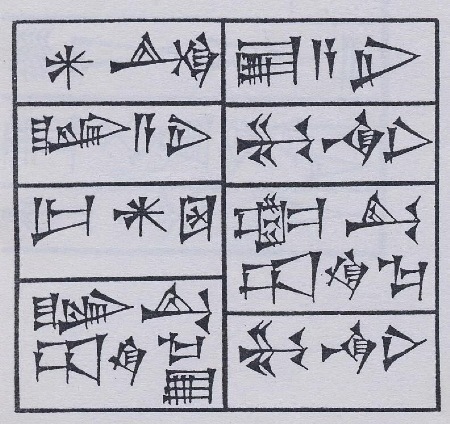Rakovsky
Active Member
Nammu was the goddess of the primordial waters and the Abzu(deep waters), and her sign was Engur. The Engur sign is written with the signs LAGAB and HAL (totality + secret).
The Lost History website says:
Professor Webster writes about Nammu's birthing of An and her role in the making of humans from clay:
I remember reading elsewhere that An the sky god also had a role in man's creation, in that he was supervising the gods at the time they decided to make man.
The Crystal Links website gives two Sumerian Creation stories, which involve Nammu and An (heavens):
Frank Smitha writes:
Are Sumerian writings unanimous that Nammu birthed An (the fatherly sky god, written with a Dingir sign), or do some say that An was uncreated too?
In the Hebrew Torah, El/Elohim/Yahweh made the heaven and earth, which were void and had watery depths (Tiamat). In Memphis, Egyptians said that Ptah (the Fashioner) created or activated the eight elements (Ogdoad), including the waters (Nut and Nunet), to make Creation. In Thebes, Egypt, it was taught that Amun (the hidden one ) made the eight elements and creation.
In Sumer, was Nammu, the goddess of the watery apzu and who has the sign Engur, uncreated and eternal such that she always existed, and alone in those properties of uncreatedness and eternality?
And what is the root meaning of the Engur sign and does it have any relation to the Dingir sign?
You can see the sign for Nammu (Engur sign) in the cuneiform below, because it uses the name Ur-Nammu, the Sumerian ruler.


As you can see, "Nammu" looks like a box with a star in the middle.
The Lost History website says:
The latter quote is from Sumerian literature, although neither passage cited mentions An's birth by Nammu.The Sumerians believed that in the beginning there was only the primeval sea, which they called Nammu ("Mankind's Mother"). Nammu gave birth to An ("Heaven") and Ki ("Earth"). It was the union of An and Ki, "heaven" and "earth", which produced the Anunnaki, or Anunna, meaning "Heaven came to Earth" or "Those who descended from Heaven to Earth." The physical union of Heaven and Earth is described in the Sumerian text The Birth of Wood and Reed:
Another text, Gilgamesh, Enkidu, and the netherworld, begins with this introduction:
- "The Great Earth made herself glorious, her body flourished with greenery. Wide Earth put on silver metal and lapis lazuli ornaments, adorned herself with diorite, chalcedony, carnelian, and diamonds. Heaven covered the pastures with irresistible sexual attraction, presented himself in majesty. The pure young woman showed herself to the pure Heaven. The vast Heaven copulated with the wide Earth, the seed of the heroes Wood and Reed he ejaculated into her womb. Sweet Earth, the good cow, received the rich seed of Heaven in her womb. The Earth, for the happy birth of the Plants of Life, presented herself."
- In those days, in those distant days, in those nights, in those remote nights, in those years, in those distant years; in days of yore, when the necessary things had been brought into manifest existence, in days of yore, when the necessary things had been for the first time properly cared for, when bread had been tasted for the first time in the shrines of the Land, when the ovens of the Land had been made to work, when the heavens had been separated from the earth, when the earth had been encircled by the heavens, when the name of mankind was fixed, when An had taken the heavens for himself...
Professor Webster writes about Nammu's birthing of An and her role in the making of humans from clay:
http://faculty.gvsu.edu/websterm/sumerianmyth.htmOnly one account of the Sumerian creation has survived, but it is a suggestive one. This account functions as an introduction to the story of "The Huluppu-Tree" (Wolkstein 4).
In the first days when everything needed was brought into being,
In the first days when everything needed was properly nourished,
When bread was baked in the shrines of the land,
And bread was tasted in the homes of the land,
When heaven had moved away from the earth,
And earth had separated from heaven,
And the name of man was fixed;
When the Sky God, An, had carried off the heavens,
And the Air God, Enlil, had carried off the earth . . . (Wolkstein 4)
"An" the male sky god and "Ki" the female earth were separated by Enlil, their son and later the chief god of the pantheon. Enlil thus carries off his mother the earth, taking his father's place in a manner somewhat similar to the way Kronos, in a much later story, usurped his father's (Ouranos') power. But where did heaven (An) and earth (Ki) come from, you may ask? According to another text, it was Nammu, the sea, "the mother, who gave birth to heaven and earth" (Kramer, Sumerian Mythology 39). In a dry climate, water is the ultimate source of life--Diane Wolkstein points out that the word for "water also means 'semen' in Sumerian" (139).
...
Nammu, who is either the sea or the goddess of the riverbed, goes to her son Enki, who is asleep in the deep (the Apsu) and entreats him to rise from his bed and "fashion servants of the gods" (Kramer, History Begins 109). Enki, who after all is the god of wisdom, thinks of the germinating powers of the clay and water of the abyss, and he tells Nammu to have some womb-goddesses pinch off this clay and have some "princely fashioners" thicken it, so she can mold it or give birth to it:
Mix the heart of the clay that is over the abyss,
The good and princely fashioners will thicken the clay,
You, [Nammu] do you bring the limbs into existence;
Ninmah [earth-mother or birth goddess] will work above you,
The goddesses [of birth] . . . will stand by you at your fashioning;
O my mother, decree its [the newborn's] fate,
Ninmah will bind upon it the image (?) of the gods,
It is man . . . . (Kramer, History Begins 109)
I remember reading elsewhere that An the sky god also had a role in man's creation, in that he was supervising the gods at the time they decided to make man.
The Crystal Links website gives two Sumerian Creation stories, which involve Nammu and An (heavens):
http://www.crystalinks.com/sumermythology.htmlCreational Myth 1 Heaven and Earth were once a mountain that rose out of the primeval Sea. The mountain's peak reached into Heaven and its base was the Earth. An was heaven, and Ki was Earth. Nammu is the Sea goddess that surrounded the Earth. She was also the original dark chaos out of which everything formed. The mountain rose up out of the blackness of the deep sea. Enlil, the Air god, separated Heaven and Earth and gave birth to the dawn.
Creational Myth 2 In about 3000 BC the Sumerians in the Middle East also had this account of Creation. The god of the waters, Enki, told his mother, Nammu, to take bits of clay and mold the shapes of men and women. She made perfect people of every sort to be servants of the gods.
Frank Smitha writes:
http://www.fsmitha.com/h1/religion-sumer.htmThe Sumerians could dig into the earth and within a few feet find water, and they believed that the earth was a great disk floating on the sea. They called the sea Nammu, and believed that Nammu was a god. They believe that Nammu had created the fish they saw and the birds, wild pigs and other creatures that appeared on the marshy wetlands – a story of creation around two millennia before the Hebrews would put their own story of the creation into writing.

The [sun] god Utu rising to shed light on heaven and earth
The Sumerians believed that Nammu had created heaven and earth, heaven splitting from earth as the male god An, and the earth was the goddess they called Ki. They believed that Ki and An had produced a son called Enlil, who was atmosphere, wind and storm. The Sumerians believed that Enlil separated the day from night and that he had opened an invisible shell and let waters fall from the sky.
Are Sumerian writings unanimous that Nammu birthed An (the fatherly sky god, written with a Dingir sign), or do some say that An was uncreated too?
In the Hebrew Torah, El/Elohim/Yahweh made the heaven and earth, which were void and had watery depths (Tiamat). In Memphis, Egyptians said that Ptah (the Fashioner) created or activated the eight elements (Ogdoad), including the waters (Nut and Nunet), to make Creation. In Thebes, Egypt, it was taught that Amun (the hidden one ) made the eight elements and creation.
In Sumer, was Nammu, the goddess of the watery apzu and who has the sign Engur, uncreated and eternal such that she always existed, and alone in those properties of uncreatedness and eternality?
And what is the root meaning of the Engur sign and does it have any relation to the Dingir sign?
You can see the sign for Nammu (Engur sign) in the cuneiform below, because it uses the name Ur-Nammu, the Sumerian ruler.


As you can see, "Nammu" looks like a box with a star in the middle.
